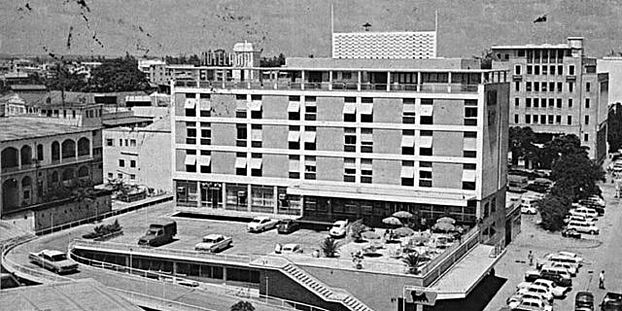Provincializing ENI’s Disegno Africano: Agip Tanzania and the Agip Motel in Dar es Salaam

Giulia Scotto
Routledge, 2021
On July 31, 1964—the year of the United Republic of Tanzania’s foundation—the government-owned Tanzanian newspaper The Nationalist published a double-page illustrated article announcing the opening of a new hotel in the center of the capital, Dar es Salaam.
The newest silhouette on the Dar es Salaam skyline, the luxurious Agip Motel, is not only a graceful addition to the face of the capital, but an important addition towards the country’s increasing interest in attracting tourists. Aimed mainly, of course, at the motorists, the £400,000 building houses facilities for any traveller– and for that matter, the local people themselves. [...] From the car showroom and petrol station at the ground level to the peaceful roof garden the motel is every inch modern. The motel has 57 tastefully decorated bedrooms, each with a toilet, shower and telephone. It is worth noting that the furnishings, which combine beauty with comfort, were made locally. The Luigi Casazana and Attilio Brunetta partners Dar es Salaam, who employ only local sta , were responsible for this. So Tanganyika can proudly boast that her own craftsmen did much towards enhancing the beauty of the motel. The building was in fact almost entirely constructed with local materials, the sole exception being tiles which are not manufactured here and had to be imported from Italy. [...] [T]he roof garden [...] o ers a delightful view of Dar es Salaam’s beautiful harbor and a striking panorama of the entire city.
Located in the city center of Dar es Salaam between the historic commercial area known as “Indian Bazaar” and the former colonial quarter, 3 the motel was built by Agip (Azienda Generale Italiana Petroli), the commercial branch of the Italian national hydrocarbon agency (Ente Nazionale Idrocarburi or ENI) as part of its disegno africano (African scheme, design, or project). ENI’s disegno—the expansion of the company into the African continent—was launched by the company’s fi rst president Enrico Mattei in 1955 to enlarge the company’s market and ensure the hydrocarbon supply to the Italian industrial sector.
The Dar es Salaam motel, together with Agip gas and service stations designed to enhance the circulation of goods and people, played a key role in defi ning and expanding ENI’s disegno, an incremental assemblage of lines and nodes through which oil was transported, refi ned, and commercialized. Far from being a linear history of brave pioneers and infrastructural achievements, as depicted in ENI’s o cial narrative, the African project took shape through negotiations and agreements with multiple local actors and despite failures and contestations. As one reads in the previous excerpt of the Nationalist article, the Dar es Salaam Agip Motel was much more than the mere materialization of ENI’s ambitions. Its presence in the core of the capital city came to symbolize the country’s potential for attracting foreign tourists and investors, its will and capacity to transform the colonially inherited urban landscape, and a showcase of Tanzanian craftsmanship.
